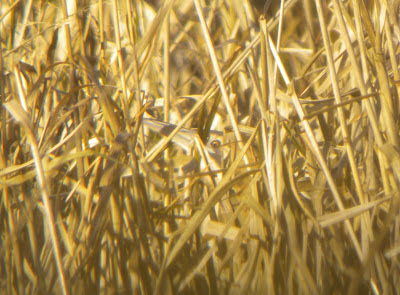Having trawled the gravel pits of Staffordshire for the last six weeks, we decided to head out of the county today. The weather was fine and we decided to head to the North Wales coast. As per usual, we had a few target birds to go for.
We started off at Westport, waiting for CJW to wake up as he was on a late shift the previous evening. Fortunately, he decided against his usual 17hr sleep, and we were heading off by 09:15hrs.
First stop was at Llanbedr-y-Cennin and we didn't have to wait too long before CJW spotted a Hawfinch flying back in and perch in full view for us at the top of one of the trees. The scope was set up and I took my camera out of my pocket and .......nothing. It was showing a lens error. Never had a problem with this cam before but after just over three years and heaven knows how many photo's I've took, it was an ex-camera. Another incident happened here as well. CJW and GAS were stood in the road, and I was slightly higher up on the path. CJW noticed I was looking thru my bins and he wondered what I was looking at. He looked, and watched a Red Kite glide over the trees giving good views. However, I was scanning the tree tops for Hawfinches, and somehow missed the Kite. It took me ages to persuade them I hadn't seen it. Usually its the other way round and I have to prove I've seen something. I dipped on this occasion, but it gave the other two something to chuckle about all day.

Hawfinch by Phil Jones. Who needs photo's!
First bird in the bag, and so onto the next stop at Llanfairfechan. We only planned a brief scan here from the promenade, but the sea was like a mill pond and there was quite a few birds to look at. On the shore were small groups of Knot and Turnstone, and on the sea, at least ten Red-throated Divers, 50+ Great Crested Grebes (never seen so many off here before. It was just like Tad Bay in the summer), six Slavonian Grebes, a few Guillemots, a drake Goldeneye, a few Scoter and Shag. All very pleasant.
Our main target here was the FIRECREST at the sewage works. I thought I knew where the sewage works was, but when we walked to the area where I thought it was, there was no sign - no sewage works! Fortunately I managed to get a signal on my phone, and we were soon heading off in the car to the correct location. We did find the sewage works and there was a birder already looking for the FIRECREST. He hadn't seen it yet, but we had received a message saying it was still present. We were soon joined by quite a few birders, but despite quite a few Goldcrest and Treecreeper, none of us could find the FIRECREST. Then a birder turned up who we had been speaking to at Llanbedr-y-Cennin. He walked up and found the Firecrest straight away. The views were good if a little bit brief.
Good drawings aren't they! Firecrest by PJ
We were on a roll, and next stop was Llandulas. We decided to give the SURF SCOTER another attempt. Again the sea was flat, so we drove onto the beach instead of the higher Llysfaen Station Road. The Scoter flocks were showing fairly well, and we managed to pick out seven Velvet Scoter, 20+ Red-throated Divers, 3+ Red-breasted Mergansers. I then found two Scaup on the edge of the flock. I was trying to show CJW the Scaup when I spotted a Scoter which appeared to have white on the back of its head. CJW tried to find it, I had the scope back but we just couldn't find the bird again. In fact, I couldn't even find the Scaup again! What a bobbing, flapping nightmare it is at Llandulas.
It was high tide at 14:40hrs, and this tied in very nicely for the PURPLE SANDPIPERS at Rhos Point. As we walked along the front it was nice to see a few Ringed Plover, Turnstones and a Dunlin - more waders than I saw on my last visit here in December. I stopped to check thru a flock of Turnstone further along when CJW jumped in, stole my thunder and found a solitary Purple Sandpiper. And despite searching, that was the only one we saw! A fine drake Eider was swimming offshore, plus we found a distant Great Northern Diver.
Final drawing from Phil - thanks for bailing me out
Time was running out and we still had two more sites to visit. Luckily, the sun was still out and we headed off to Flint Castle for the TWITE. There were a few birders still on site, but the TWITE flock had been flushed by the Black-headed Gulls being fed. We walked off in the general direction where they flew to, but there was no sign. While we were walking along the front, a rugby match was taking place. In the short time it took us to walk to the end and back, three players had injured themselves and were lying on the edge of the pitch all in various states and conditions. Amazingly, both teams still had 15 players each.
The light was now fading and we had one last place to visit - Parkgate which was directly opposite Flint. We hurtled round and by about 16:20hrs we were parked up. We were soon watching two male Hen Harriers and a Short-eared Owl. We could see quite a few Little Egrets, but the GREAT WHITE EGRET was not so forth coming. We drove down to the other end of Parkgate, but by this time, most of the Little Egrets had flown off to roost. We did managed to add Barn Owl, Merlin and ringtail Hen Harrier to the day list!












































